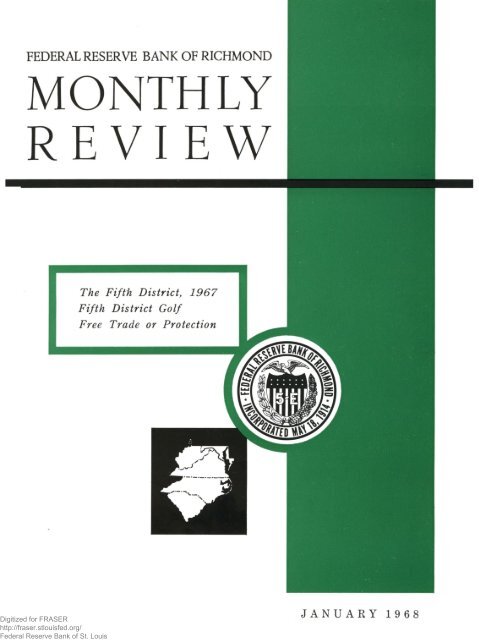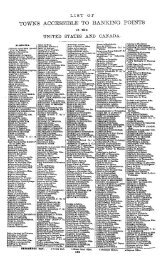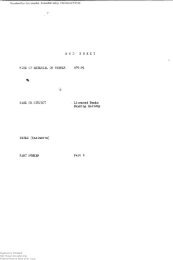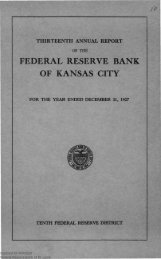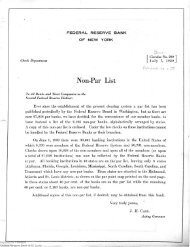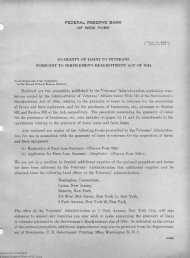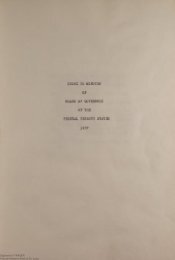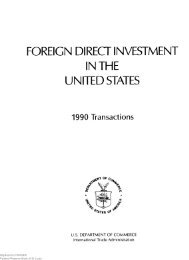Download File (6.3M) - Fraser - Federal Reserve Bank of St. Louis
Download File (6.3M) - Fraser - Federal Reserve Bank of St. Louis
Download File (6.3M) - Fraser - Federal Reserve Bank of St. Louis
Create successful ePaper yourself
Turn your PDF publications into a flip-book with our unique Google optimized e-Paper software.
Digitized for FRASER<br />
http://fraser.stlouisfed.org/<br />
<strong>Federal</strong> <strong>Reserve</strong> <strong>Bank</strong> <strong>of</strong> <strong>St</strong>. <strong>Louis</strong><br />
FEDERAL RESERVE BANK OF RICHMOND<br />
MONTHLY<br />
REVIEW<br />
The Fifth District, 1967<br />
Fifth District G olf<br />
Free Trade or Protection
THE FIFTH DISTRICT EC<br />
A Review<br />
For both the United <strong>St</strong>ates and the five-state area<br />
comprising the Fifth <strong>Federal</strong> <strong>Reserve</strong> District, 1967<br />
has gone on record as a year <strong>of</strong> considerably less<br />
ebullience than either <strong>of</strong> its two immediate predecessors.<br />
Over much <strong>of</strong> the year, the national economy<br />
grappled with the problem <strong>of</strong> inflation, with consumer<br />
prices rising at an average monthly rate <strong>of</strong> about<br />
.2%, or faster than in either 1965 or 1966. This<br />
acceleration in price increases began in a context <strong>of</strong><br />
slackened growth in aggregate demand as a major<br />
inventory adjustment significantly dampened growth<br />
in the first half. Largely as a result <strong>of</strong> the inventory<br />
adjustment, considerable unused plant capacity<br />
emerged early in the year, and until late<br />
autumn, the unemployment rate edged upward.<br />
As the inventory adjustment proceeded, real growth<br />
in the economy slowed to a snail’s pace. But heavy<br />
government outlays coupled with a smart recovery in<br />
residential construction at least kept the business<br />
advance alive in spite <strong>of</strong> the sharp turnaround in<br />
inventory demand. The inventory adjustment was<br />
largely over by July, and business activity in the<br />
second half strengthened. Even this mid-year recovery,<br />
however, was not as great as many economists<br />
and businessmen had anticipated. Large-scale work<br />
stoppages in the fall <strong>of</strong> 1967 were responsible to some<br />
degree for the slower than expected pace. Moreover,<br />
the uncertainty surrounding the tax surcharge<br />
proposal in the latter months <strong>of</strong> the year apparently<br />
kept many businessmen and consumers from formulating<br />
expenditure plans clearly or from making<br />
expenditures.<br />
The Fifth District shared these problems with the<br />
nation, but to a different degree. While no very<br />
precise measures are possible it appears that the<br />
economy <strong>of</strong> the Fifth District fared somewhat better<br />
on average through 1967 than did the nation at large.<br />
M ajor District industries, especially textiles and<br />
furniture, were affected by the inventory adjustments<br />
in the first half, but recovered by early fall.<br />
Chart 1 SELECTED FIFTH DISTRICT M<br />
Per Cent <strong>of</strong> U. S. Total<br />
Digitized for FRASER<br />
http://fraser.stlouisfed.org/<br />
<strong>Federal</strong> <strong>Reserve</strong> <strong>Bank</strong> <strong>of</strong> <strong>St</strong>. <strong>Louis</strong><br />
I I Employment Q Payroll Q Value Added by Manufact
DN<br />
<strong>of</strong><br />
W ork stoppages associated with labor disputes in the<br />
fall had less dampening effect in the District than<br />
in the nation. It was generally true in 1967 that<br />
changes <strong>of</strong> pace in economic activity in the Fifth District<br />
were less sharp and the consequences less severe<br />
than for the nation as a whole. T o some extent, the<br />
more even pattern <strong>of</strong> economic activity in the Fifth<br />
District states is due to a different industrial mix<br />
than in the whole <strong>of</strong> the United <strong>St</strong>ates.<br />
District Manufacturing<br />
Chart I gives a picture<br />
<strong>of</strong> the relative importance <strong>of</strong> selected manufacturing<br />
industries in the Fifth <strong>Federal</strong> <strong>Reserve</strong> District. The<br />
eight industry groups represented are those for which<br />
the Fifth District share <strong>of</strong> either employment, payrolls,<br />
value added, or new capital expenditures comprises<br />
more than 10% <strong>of</strong> the United <strong>St</strong>ates total for<br />
that industry. Tobacco manufactures, textile mill<br />
products, and furniture are the three industries most<br />
closely associated with the Fifth District. The District,<br />
for example, accounted for about 70% <strong>of</strong> the<br />
value added in the tobacco industry in the 1963<br />
census year. In textile mill products for the same<br />
year, that fraction was 43% , and in furniture, 19%.<br />
The other industries are shown for comparison. All<br />
those shown are important in the Fifth District, and<br />
certain industries, such as chemicals, have increased<br />
in importance in the District economy since 1963.<br />
Chart II shows the relationship <strong>of</strong> all Fifth District<br />
manufacturing to all manufacturing in the<br />
United <strong>St</strong>ates in the 1963 census year. Value added<br />
in the Fifth District comprised 7.7% <strong>of</strong> the United<br />
<strong>St</strong>ates total. New capital expenditures in manufacturing<br />
in the District were 9.5% <strong>of</strong> the U. S. total;<br />
total manufacturing payrolls were 7.2% ; and total<br />
manufacturing employment was 9.0% . Durable<br />
goods production in the District, as a percentage <strong>of</strong><br />
the national total, remains relatively small. The<br />
largest share <strong>of</strong> manufacturing activity in the District<br />
is in the nondurable lines.<br />
JFACTU RING INDUSTRIES, 1963<br />
Per Cent <strong>of</strong> U. S. Total<br />
100<br />
Furniture and Fixtures<br />
Paper and Allied Products Chemical and Allied Products <strong>St</strong>one, Clay and Glass Products<br />
80<br />
60<br />
40<br />
20<br />
r" J l<br />
1 1<br />
1t "<br />
Digitized for FRASER<br />
| New Capital Expenditures<br />
http://fraser.stlouisfed.org/<br />
Source: Census <strong>of</strong> Manufacturers.<br />
<strong>Federal</strong> <strong>Reserve</strong> <strong>Bank</strong> <strong>of</strong> <strong>St</strong>. <strong>Louis</strong><br />
■<br />
f .<br />
■<br />
1<br />
■1<br />
it
Chart II<br />
ALL DISTRICT MANUFACTURING INDUSTRIES, 1963<br />
Per Cent <strong>of</strong> U. S. Total<br />
Source:<br />
Census <strong>of</strong> Manufacturers.<br />
For those manufacturing industries important to<br />
the Fifth District, 1967 was a relatively prosperous<br />
year, despite the slowing <strong>of</strong> general economic activity.<br />
In the textile industry, manufacturing man-hours remained<br />
consistently under 1966 levels throughout<br />
1967, by 3 to 5% on a month-to-month basis, and<br />
textile output for 1967 showed about the same performance.<br />
Prices <strong>of</strong> textile mill products did not<br />
increase on balance throughout 1967, and the same<br />
was true <strong>of</strong> 1966. Textile wages moved upward<br />
slightly during the year. In the textile industry<br />
there has been considerable discussion and a number<br />
<strong>of</strong> hearings concerning the impact <strong>of</strong> imports on the<br />
domestic industry. This was due in part to the fact<br />
that 1967 was the year in which the Long-Term<br />
Arrangement for trade in textiles, negotiated through<br />
the General Agreement on Tariffs and Trade in 1962<br />
had to be renegotiated. The Long-Term Arrangement<br />
remained substantially unchanged as <strong>of</strong> year end.<br />
Concern over imports has intensified in recent weeks<br />
due to the British devaluation, and the simultaneous<br />
Hong Kong devaluation.<br />
In cigarettes, that aspect <strong>of</strong> tobacco manufacturing<br />
most concentrated in Fifth District states, production<br />
as <strong>of</strong> October 1, 1967, was running ahead <strong>of</strong> 1966<br />
by about 5% .<br />
Tobacco manufacturing man-hours<br />
have increased slightly on balance throughout the<br />
year.<br />
Furniture industry statistics likewise indicate<br />
a substantially increased volume <strong>of</strong> business in the<br />
latter part <strong>of</strong> 1967, and industry spokesmen are looking<br />
forward to a prosperous new year.<br />
Digitized for FRASER<br />
http://fraser.stlouisfed.org/<br />
<strong>Federal</strong> <strong>Reserve</strong> <strong>Bank</strong> <strong>of</strong> <strong>St</strong>. <strong>Louis</strong><br />
The chemical<br />
industry in the District made a considerable recovery<br />
after a slump early in the year.<br />
Chart III compares District manufacturing employment<br />
in 1967 to previous years. The estimated<br />
figure for 1967 indicates an increase <strong>of</strong> only .2%<br />
over 1966, but 1966 posted a large gain <strong>of</strong> 5.8%<br />
over 1965. The estimated number <strong>of</strong> persons employed<br />
in manufacturing in the District in 1967, as<br />
an annual average, is 1,725,000, an increase <strong>of</strong> about<br />
five thousand over the 1966 average. Chart IV gives<br />
the picture for manufacturing man-hours in the District.<br />
Estimates indicate slight declines in manhours<br />
in both durables and nondurables. Total manhours<br />
declined from 1966 by an estimated 2.4% . In<br />
the nondurable category this decline was 2.0% , and in<br />
durables, the decline was 3.0% . These estimated<br />
declines followed rather sizable increases in 1966, <strong>of</strong><br />
3.5% in the total, 2.5% in nondurables, and 5.2%<br />
in durables.<br />
The .2% increase in District manufacturing employment<br />
compares with a .6% estimated increase<br />
for the nation in 1967. The District decline in manhours<br />
<strong>of</strong> 2.4% compares with an estimated national<br />
decline <strong>of</strong> 1.3% for 1967.<br />
Total Employment and Income Chart III indicates<br />
that nonmanufacturing employment in the District<br />
in 1967 posted a more impressive gain than did<br />
that in the manufacturing sector. Nonmanufacturing<br />
employment, based on 1967 estimates, averaged<br />
4.2 million, 71% <strong>of</strong> total nonagricultural employ<br />
Chart III<br />
Millions<br />
NONAGRICULTU<br />
F I F T hP<br />
1961 1963 1965 1967<br />
Note: 1967 figures partially estimated.<br />
Source:<br />
<strong>St</strong>ate Departments <strong>of</strong> Labor.
ment, and nearly 2 x/2 times manufacturing employment.<br />
The estimated increase in the nonmanufacturing<br />
sector was 3.2% in 1967, while the estimated increase<br />
in total nonagricultural employment was 2.4% .<br />
By comparison, the national total <strong>of</strong> nonagricultural<br />
employment rose by an estimated 2.9% during 1967.<br />
Of nonmanufacturing employment in the Fifth District,<br />
the largest increase during 1967 was in government<br />
employment, an estimated gain <strong>of</strong> 5.6%. Estimated<br />
average government employment in the District<br />
was 1.26 million in 1967, an increase <strong>of</strong> about<br />
67,000 over 1966. The District gain compares to<br />
a nationwide increase in government employment in<br />
1967 <strong>of</strong> an estimated 651,000, or 6.0% .<br />
The services area has also accounted for large employment<br />
gains during the past year. In the Fifth<br />
District, this increase is estimated at 3.9%, or about<br />
30,000. Nationally, the estimated 1967 increase was<br />
5.1%, or about 490,000. Estimates for the District<br />
also show increases in employment <strong>of</strong> 2.4% in transportation<br />
and public utilities, and 3.8% in finance<br />
and insurance in 1967.<br />
Table 1 presents estimated personal income<br />
statistics for the Fifth District states for 1967 and<br />
percentage changes from the previous year. Estimates<br />
for 1967 are second quarter figures at seasonally<br />
adjusted annual rates. Of interest in Table 1<br />
is the comparison <strong>of</strong> the Fifth District with the<br />
United <strong>St</strong>ates. District states grew relatively more<br />
in terms <strong>of</strong> both total and per capita personal income<br />
L EMPLOYMENT<br />
R I C T<br />
Millions<br />
1.50<br />
1.25<br />
J.00<br />
.75<br />
.50<br />
.25<br />
0<br />
1961 1963 1965 1967<br />
Digitized for FRASER<br />
http://fraser.stlouisfed.org/<br />
<strong>Federal</strong> <strong>Reserve</strong> <strong>Bank</strong> <strong>of</strong> <strong>St</strong>. <strong>Louis</strong><br />
Chart IV<br />
Mil . Per Week<br />
70<br />
60<br />
50<br />
40<br />
30<br />
20<br />
FACTORY MAN-HOURS<br />
0<br />
1961 1963 1965 1967<br />
Note: 1967 figures partially estimated.<br />
Source: <strong>St</strong>ate Departments <strong>of</strong> Labor.<br />
during the year than the nation. Per capita personal<br />
income in the District, however, remains below<br />
the national average in all states except Maryland<br />
and the District <strong>of</strong> Columbia. Some <strong>of</strong> the explanation<br />
for the relatively high rates <strong>of</strong> growth in both<br />
total and per capita income in Maryland, D. C., and<br />
Table 1 FIFTH DISTRICT PERSONAL IN C O M E -1967*<br />
Total<br />
Per Capita<br />
Change<br />
Change<br />
Amount 66-67 Amount 66-67<br />
($ Billions) % (Dollars) %<br />
Md. 12.5 7.9 3,390 5.8<br />
D. C. 3.4 6.9 4,203 6.5<br />
Va. 12.5 7.0 2,748 5.5<br />
W. V a.f 4.1 4.6 2,290 5.2<br />
N. C. 11.8 4.1 2,345 3.0<br />
S. C. 5.5 4.3 2,128 3.7<br />
5th District 49.8 6.0 2,698 4.8<br />
U. S. 613.3 5.7 3,099 4.6<br />
*Estimated<br />
Source:<br />
FIFTH DISTRICT<br />
f Includes entire state.<br />
U. S. Department <strong>of</strong> Commerce.<br />
Virginia is the influence <strong>of</strong> the boom-type expansion<br />
<strong>of</strong> the nation’s capital.<br />
Retail Trade There is some evidence that retail<br />
trade on a nationwide basis was somewhat under<br />
that which businessmen expected in 1967, par-<br />
( Continued on page 8)<br />
5
Digitized for FRASER<br />
http://fraser.stlouisfed.org/<br />
<strong>Federal</strong> <strong>Reserve</strong> <strong>Bank</strong> <strong>of</strong> <strong>St</strong>. <strong>Louis</strong>
Digitized for FRASER<br />
http://fraser.stlouisfed.org/<br />
<strong>Federal</strong> <strong>Reserve</strong> <strong>Bank</strong> <strong>of</strong> <strong>St</strong>. <strong>Louis</strong>
THE FIFTH DISTRICT ECONOMY IN FOCUS<br />
(Continued from page 5)<br />
ticularly during fall and winter months. This<br />
probably can be attributed in part to consumer uncertainty<br />
about future tax increases. Fifth District<br />
retail trade held up relatively better than in the<br />
nation. Chart V presents a comparison <strong>of</strong> estimated<br />
1967 retail sales and trade employment with earlier<br />
years. Retail sales for the year were under the<br />
1966 figure by an estimated .9%. Estimated trade<br />
employment for 1967, on the other hand, increased<br />
by 1.6% over the previous year.<br />
Construction W hile the index <strong>of</strong> value <strong>of</strong> con <br />
struction contracts issued in the Fifth District in<br />
1967 ran consistently above the nation at large, it<br />
failed to regain the peak it reached in July, 1966.<br />
In late 1967, beginning approximately in October, a<br />
further tapering <strong>of</strong>f was evident in the District index.<br />
This was probably attributable to rapidly rising interest<br />
rates, rising building costs, and uncertainty<br />
over the future course <strong>of</strong> economic policy.<br />
plots the progress <strong>of</strong> the construction industry.<br />
Chart V I<br />
On<br />
an estimated basis, the 1967 gain in total construction<br />
contracts was about 1.6% over 1966.<br />
In residential<br />
construction, there was an estimated decline<br />
<strong>of</strong> 4.0% from 1966, and a decline <strong>of</strong> about 20.0%<br />
Chart V FIFTH DISTRICT TRADE<br />
$ Billion Thousands<br />
1961 1963 1965 1967<br />
“Based on firms operating 1-10 establishments.<br />
Digitized for FRASER<br />
Note: 1967 figures partially estimated.<br />
http://fraser.stlouisfed.org/<br />
Source: Bureau <strong>of</strong> the Census and the <strong>St</strong>ate Depart-<br />
<strong>Federal</strong> <strong>Reserve</strong> <strong>Bank</strong> <strong>of</strong> <strong>St</strong>. <strong>Louis</strong><br />
Chart VI<br />
CONSTRUCTION<br />
Thousands 1957-1959=100<br />
from the 1965 peak. Industrial contracts were <strong>of</strong>f<br />
in the District in 1967 also, and it was other commercial<br />
contracts which filled the gap to produce the<br />
slight gain in the total. Estimated construction employment<br />
declined by a very slight .5% during 1967.<br />
<strong>Bank</strong>ing Chart V II indicates the progress <strong>of</strong><br />
banking in the Fifth District in 1967, in relation to<br />
earlier years <strong>of</strong> the sixties. On an estimated basis<br />
for the year, time deposits in District banks made<br />
the most spectacular gain <strong>of</strong> four series plotted. Time<br />
deposits increased 15.5% during the year, as compared<br />
to a 2.5% increase in demand deposits.<br />
The<br />
estimated increase in average time deposits was $862<br />
million, compared to an increase <strong>of</strong> an estimated<br />
$192 million in demand deposits for Fifth District<br />
banks.<br />
Investments increased during 1967 by an<br />
estimated $462 million, or 11.7%, while gross loans<br />
increased an estimated $551 million, or 6.5% .<br />
Developments in banking roughly paralleled the<br />
national pattern.<br />
The slower growth <strong>of</strong> loans was<br />
due in part to weaker loan demand associated with<br />
the slower pace <strong>of</strong> economic activity, to much slower<br />
inventory accumulation and to repayment <strong>of</strong> bank<br />
loans out <strong>of</strong> the proceeds <strong>of</strong> record corporate bond<br />
sales.<br />
Construction Employment<br />
(Thousands)<br />
1961 1963 1965 1967<br />
Note: 1967 figures partially estimated.<br />
Source:<br />
Index <strong>of</strong> Residential Contracts<br />
(1957-1959 = 100)<br />
Index <strong>of</strong> Total<br />
Construction<br />
(1957-1959 = 100)<br />
The Dodge Co. and <strong>St</strong>ate Departments <strong>of</strong> Labor.<br />
At the same time banks have added heavily<br />
to investments, putting to work the reserves which
have been injected in record amounts by <strong>Federal</strong><br />
Open Market operations.<br />
<strong>St</strong>ate Finance T a x revenues grew substantially<br />
in all Fifth District states in 1967. Table 2 shows<br />
this information on a total and per capita basis. Of<br />
interest again is the comparison in Table 2 <strong>of</strong> the<br />
Chart VIII<br />
DISTRIBUTION OF STATE TAX REVENUES BY TYPE<br />
FIFTH DISTRICT* —1967<br />
Table 2<br />
STATE TAX REVENUES<br />
Fifth District <strong>St</strong>ates<br />
Total<br />
Per Capita<br />
1967* 1966 Change 1967* 1966 Changi<br />
($ millions) % (doillars) %<br />
Md. 641 588 9.1 174 163 6.9<br />
Va. 635 529 20.0 140 118 18.3<br />
W. V a.f 282 264 6.6 157 146 7.3<br />
N. C. 841 777 8.2 167 156 7.0<br />
S. C. 396 359 10.2 152 139 9.5<br />
5th District 2,795 2,517 11.0 158 144 9.8<br />
U. S. 31,910 29,388 8.6 162 151 7.5<br />
*Estimated fl^ u ^ e s entire state.<br />
Source: U. S. Department <strong>of</strong> Commerce.<br />
District with all states <strong>of</strong> the nation. Increases in<br />
the Fifth District were somewhat larger in total and<br />
per capita. Virginia experienced the largest increase<br />
in total and per capita <strong>of</strong> the five states, followed by<br />
South Carolina. Per capita tax revenue is higher<br />
than that throughout the nation in both Maryland<br />
and North Carolina, for both years shown.<br />
Chart VII<br />
$ Billion<br />
10<br />
BANKING TRENDS<br />
FIFTH DISTRICT MEMBER BANKS<br />
0<br />
1961 1963 1965<br />
Digitized Note: for FRASER 1967 figures partially estimated.<br />
http://fraser.stlouisfed.org/<br />
<strong>Federal</strong> <strong>Reserve</strong> <strong>Bank</strong> <strong>of</strong> <strong>St</strong>. <strong>Louis</strong><br />
‘ Excludes D. C. and includes all <strong>of</strong> West Virginia.<br />
Source: U. S. Department <strong>of</strong> Commerce.<br />
The estimated District population increase in 1967<br />
was about 200,000, or 1.1%. By states, the estimated<br />
per cent increases in 1967 w ere: Maryland, 2 .0 % ;<br />
D. C., .4 % ; Virginia, 1.5% ; North Carolina, 1.1% ;<br />
South Carolina, .6%. West Virginia, on the other<br />
hand, declined in population by an estimated .6%,<br />
or about 11,000 people. Thus, both state tax revenues<br />
and income (Table 1) increased at faster rates than<br />
did the population throughout the District.<br />
Chart V III shows the sources <strong>of</strong> state tax revenues<br />
in percentage terms by type for the Fifth District as<br />
a whole in 1967.<br />
Agriculture T obacco farmers in the District<br />
brought in higher yields, but experienced lower prices<br />
and a lower-than-expected quality during the 1967<br />
marketing season. Gross returns increased over the<br />
previous year, but a shift in demand on the part <strong>of</strong><br />
buying firms from previously preferred mid-stalk<br />
leaves to lower-stalk varieties, as well as the quality<br />
problem, were largely responsible for the price decline.<br />
The result is that the percentage <strong>of</strong> the crop<br />
placed under government loan increased significantly.<br />
The year’s cotton crop in the District and in the<br />
nation set record lows. The 1967 crop was the<br />
smallest for the District states on record, due to<br />
damp and cold weather during growing season and<br />
high bug infestation. Nationally, cotton produced<br />
was the lowest since 1895. A large increase in<br />
cotton prices has resulted, and serious concern<br />
has developed among textile producers about possible<br />
shortages in the supply <strong>of</strong> cotton during<br />
the coming year.<br />
William H. Wallace
10<br />
Digitized for FRASER<br />
http://fraser.stlouisfed.org/<br />
<strong>Federal</strong> <strong>Reserve</strong> <strong>Bank</strong> <strong>of</strong> <strong>St</strong>. <strong>Louis</strong><br />
FREE TRADE OR PROTECTION<br />
An Old Controversy Renewed<br />
The Kennedy Round negotiations have once again<br />
focused attention on various problems concerning<br />
international trade. According to many economists,<br />
a free flow <strong>of</strong> goods and services over the world<br />
is in the interest <strong>of</strong> all countries. Yet arguments to<br />
justify protection have always been readily found,<br />
and today both tariff and non-tariff barriers to trade<br />
are widely used as a matter <strong>of</strong> policy. In an effort<br />
to reduce such barriers, delegations from some 50<br />
countries have met in Geneva during the past four<br />
years to discuss such problems as the lowering <strong>of</strong><br />
duties, the widening <strong>of</strong> quotas, and the use <strong>of</strong><br />
“ escape clauses” in trade agreements.<br />
This article reviews briefly some <strong>of</strong> the theoretical<br />
aspects <strong>of</strong> the controversy between free-traders and<br />
protectionists and considers certain features <strong>of</strong> some<br />
<strong>of</strong> the trade barriers currently employed by the<br />
trading nations <strong>of</strong> the world.<br />
The “ Classical” Theory <strong>of</strong> Free Trade One <strong>of</strong><br />
the most persuasive advocates <strong>of</strong> free trade was “ the<br />
father <strong>of</strong> economics,” Adam Smith. Published in<br />
1776, Wealth <strong>of</strong> Nations eloquently sets forth why<br />
and when countries will benefit from international<br />
trade. Although other economists <strong>of</strong> the so-called<br />
“ Classical School” later elaborated his theories,<br />
Smith’s ideas have had a lasting influence on<br />
economic thought.<br />
“ It is the maxim <strong>of</strong> every prudent master <strong>of</strong> a<br />
family, never to attempt to make at home, what it<br />
will cost him more to make than to buy,” said Smith.<br />
“ The tailor does not attempt to make his own shoes,<br />
but buys them <strong>of</strong> the shoemaker. . . . ”<br />
“ What is prudence in the conduct <strong>of</strong> every private<br />
family, can scarce be folly in that <strong>of</strong> a great kingdom.<br />
If a foreign country can supply us with a commodity<br />
cheaper than we ourselves can make it, better buy it<br />
<strong>of</strong> them with some part <strong>of</strong> the produce <strong>of</strong> our own<br />
industry employed in a way in which we have some<br />
advantage.”<br />
Smith believed firmly in the benefits to be gained<br />
from an international division <strong>of</strong> labor. Like persons,<br />
countries should specialize in the production <strong>of</strong> those<br />
goods which they could produce most efficiently. An<br />
individual nation’s relative advantage over other<br />
nations could be based on the relative abundance <strong>of</strong><br />
a certain factor <strong>of</strong> production in the country, on<br />
peculiarities <strong>of</strong> climate, on some unique characteristic<br />
<strong>of</strong> its population, or on any <strong>of</strong> a variety <strong>of</strong> other<br />
factors.<br />
W orld-wide specialization would be significant,<br />
according to Smith, only if the resulting products<br />
could be exchanged freely against each other. As<br />
he saw it, prolonged state intervention in international<br />
trade would be harmful except in two specific<br />
cases. First, he recognized that it might be expedient<br />
to protect an industry that is <strong>of</strong> vital importance<br />
for the national security. Second, he agreed<br />
to a tariff on imported products if the same goods<br />
made inside the country are exposed to excises.<br />
Temporary duties could be levied as an instrument<br />
<strong>of</strong> retaliation.<br />
These ideas clashed with the mercantilistic maxims<br />
that had prevailed in varying degrees <strong>of</strong> sophistication<br />
for some time. The supporters <strong>of</strong> mercantilism in its<br />
cruder forms held that a country’s wealth depended<br />
predominantly on its stock <strong>of</strong> precious metals. A<br />
nation possessing no gold and silver mines could enlarge<br />
its riches only through the creation <strong>of</strong> a balance<br />
<strong>of</strong> trade surplus, as this would result in an inflow <strong>of</strong><br />
precious metals. T o attain such a positive position,<br />
a policy <strong>of</strong> restriction <strong>of</strong> imports and stimulation <strong>of</strong><br />
exports was advocated.<br />
The basis <strong>of</strong> mercantilism had been attacked in
England as early as 1752 when David Hume showed<br />
the futility <strong>of</strong> building up stocks <strong>of</strong> gold and silver<br />
as an end in itself. Smith now demonstrated that<br />
nations would in fact benefit from unhampered international<br />
trade. He reasoned that whenever two<br />
countries, A and B could produce two products, X<br />
and Y, and A had an advantage in the production <strong>of</strong><br />
X , whereas B could produce Y at a lower cost, it<br />
would be in both parties’ interest to establish trade<br />
connections. This is the basis <strong>of</strong> the free trade<br />
doctrine; later authors like David Ricardo and John<br />
<strong>St</strong>uart Mill refined and extended it considerably.<br />
Arguments in Favor <strong>of</strong> Protection One <strong>of</strong> the<br />
earliest attacks 011 Smith’s free trade doctrine came<br />
in Alexander Hamilton’s “ Report 011 Manufactures.”<br />
This document, drafted in 1791, contained a survey<br />
<strong>of</strong> the contemporary situation <strong>of</strong> U. S. industries and<br />
urged a protectionist policy to stimulate industrial<br />
growth.<br />
Hamilton first explained why establishment <strong>of</strong> industries<br />
in the young, still predominantly agricultural,<br />
republic was desirable. He pointed out that reasons<br />
<strong>of</strong> military security and <strong>of</strong> national development<br />
spoke strongly for it. The mere fact that an industry<br />
did not exist in a country, he said, did not imply<br />
that it was obviously not advantageous to establish<br />
it. It could well be that a private entrepreneur<br />
might hesitate to enter upon production, as full exposure<br />
to competition <strong>of</strong> imported products during<br />
the industry’s infancy could result in heavy initial<br />
losses. In those cases where it would be in the interest<br />
<strong>of</strong> the country if the particular industry were<br />
to be established, but where private initiative alone<br />
would not bring it forth, temporary governmental<br />
protection could prove beneficial. On its maturity,<br />
according to this argument, the new industry could<br />
then safely be exposed to foreign competition. In<br />
short, Hamilton advocated a government-directed<br />
commercial policy aimed at promoting industrialization,<br />
as opposed to a “ laissez-faire” policy. He felt<br />
that import duties, export premiums, bounties, and<br />
other forms <strong>of</strong> government intervention could be employed<br />
judiciously to achieve this end.<br />
The so-called “ infant industry” argument for protection<br />
reflects the diverging interests <strong>of</strong> countries<br />
with unequal levels <strong>of</strong> development. In the United<br />
<strong>St</strong>ates <strong>of</strong> Hamilton’s day, newly established industries<br />
had to compete with experienced European firms.<br />
If left without help, many would likely have died a<br />
premature death.<br />
While admitting the general plausibility <strong>of</strong> this<br />
argument, free trade advocates immediately indicated<br />
its weak points.<br />
Digitized for FRASER<br />
http://fraser.stlouisfed.org/<br />
<strong>Federal</strong> <strong>Reserve</strong> <strong>Bank</strong> <strong>of</strong> <strong>St</strong>. <strong>Louis</strong><br />
They pointed out that it is very<br />
difficult to judge in advance whether an infant industry<br />
should be eligible for support in terms <strong>of</strong><br />
long-run benefits. They were also concerned that<br />
protective devices, though meant to be temporary,<br />
might become permanent.<br />
Most other arguments in favor <strong>of</strong> protection have<br />
received little support from economists. Many are<br />
applicable only in special circumstances. It is, for<br />
instance, frequently heard that countries should protect<br />
themselves against imports from nations where<br />
labor is relatively cheap, on grounds that these imports<br />
might jeopardize the high level <strong>of</strong> wages and<br />
employment in the importing country. It frequently<br />
has been pointed out that this argument confuses<br />
wage rates and unit labor costs. Because <strong>of</strong> superior<br />
training, health, and capital equipment, unit labor<br />
costs in “ high-wage” countries may actually be equal<br />
to or lower than unit labor costs in “ low-wage”<br />
countries. In such a case, there would be little<br />
danger that low-wage countries could capture the<br />
markets <strong>of</strong> high-wage countries.<br />
Any protectionist policy has the drawback that it<br />
may provoke retaliation. Experience suggests that<br />
when one country starts imposing duties upon imports,<br />
others will soon follow. This tends to shrink<br />
the volume <strong>of</strong> multilateral trade, thus detracting from<br />
the world-wide division <strong>of</strong> labor.<br />
Instruments <strong>of</strong> Protection Generally students <strong>of</strong><br />
foreign trade make a distinction between tariff and<br />
non-tariff barriers. The former group consists <strong>of</strong><br />
import and export duties, the latter <strong>of</strong> quantitative<br />
restrictions, embargoes and various kinds <strong>of</strong> administrative<br />
protection.<br />
Export duties, which are used by many countries,<br />
are unconstitutional in the U. S., but import duties<br />
are used here as well as abroad. Import duties can<br />
be levied in several ways and for various purposes.<br />
Ad valorem duties for instance, are expressed as a<br />
percentage <strong>of</strong> the value <strong>of</strong> the imported goods,<br />
whereas specific duties consist <strong>of</strong> a fixed fee per<br />
physical unit <strong>of</strong> imports. Since this last method does<br />
not consider price differences <strong>of</strong> goods within the<br />
same category, it in fact lays a heavier burden upon<br />
products with lower unit prices, and its effectiveness<br />
is reduced when prices rise. When applying ad<br />
valorem duties, the question arises how to determine<br />
the value <strong>of</strong> the imported good. Should duties be<br />
based on the value <strong>of</strong> the good in the country <strong>of</strong><br />
origin or on values in the receiving country ? Should<br />
the value be measured by wholesale or retail prices?<br />
Should f.o.b. quotations or c.i.f. prices be decisive?<br />
The U. S. Bureau <strong>of</strong> Customs uses various methods<br />
<strong>of</strong> valuation.<br />
The dutiable value is generally based<br />
11
12<br />
Digitized for FRASER<br />
http://fraser.stlouisfed.org/<br />
<strong>Federal</strong> <strong>Reserve</strong> <strong>Bank</strong> <strong>of</strong> <strong>St</strong>. <strong>Louis</strong><br />
on the “ foreign value” and less frequently on the<br />
“ export value.” There are, however, exceptions to<br />
this practice. In some instances, dutiable value is<br />
based on the wholesale price in the United <strong>St</strong>ates<br />
<strong>of</strong> the competitive domestic product. In other cases,<br />
dutiable value is based on the wholesale price in the<br />
United <strong>St</strong>ates <strong>of</strong> the imported product, less most <strong>of</strong><br />
the expenses incurred in bringing the product to this<br />
country and marketing it.<br />
Tariffs can also be used as an instrument <strong>of</strong> commercial<br />
discrimination. Sometimes the same duty<br />
applies to all nations; <strong>of</strong>ten, however, some countries<br />
get preferential treatment. The British Commonwealth<br />
members, for instance, have for over thirty<br />
years granted lower duties to each other than to outside<br />
countries. Generally, the United <strong>St</strong>ates follows<br />
the “ Most Favored Nation” principle and concedes<br />
to all trading parties, with certain specified exceptions,<br />
any favorable treatment accorded to any other<br />
trading partner.<br />
Import duties are frequently referred to either as<br />
“ protective tariffs” or as “ revenue tariffs.” The<br />
distinction between protective and revenue tariffs<br />
refers to the purpose <strong>of</strong> the duty. Generally, though<br />
not always, both elements are present. If the duty<br />
is so high that it becomes in fact prohibitive, protectionist<br />
motives are clear. If on the other hand<br />
a tariff is not so high as to exclude an import, and<br />
is levied on goods that the country itself does not<br />
produce, revenue purposes are usually paramount.<br />
Quantitative Restrictions Between the simple<br />
tariff and a quantitative restriction stands the tariff<br />
quota which combines features <strong>of</strong> both. It is a<br />
regulation by which a limited quantity <strong>of</strong> a certain<br />
product can be imported at a special low duty. Any<br />
additional amount, however, is subject to a higher<br />
duty. Quotas <strong>of</strong> this kind are generally used when<br />
domestic output <strong>of</strong> the good is low, either for seasonal<br />
or other reasons. This system may have troublesome<br />
side effects, however. Unless provisions to the contrary<br />
are made, every time a new tariff quota period<br />
is opened, a large influx will occur until the quota<br />
has been reached. This practice may disturb the<br />
national market, causing prices to fall, to the disadvantage<br />
<strong>of</strong> both local companies and importers.<br />
Similar objections can be made to the use <strong>of</strong> the<br />
“ global fixed quota.” In this case, an absolute limit<br />
is set to the quantity <strong>of</strong> a good that can be imported<br />
during a period.<br />
A variant <strong>of</strong> this is the so-called<br />
“ allocated quota,” under which allocations may be<br />
based on the percentage share that a foreign supplier<br />
holds in total imports during a certain “ base” year.<br />
Some observers object to allocated quotas on grounds<br />
that they tend to make trade relations rigid, as they<br />
do not allow new suppliers to enter. A major attraction<br />
<strong>of</strong> this method to some countries lies in the<br />
fact that allocation <strong>of</strong> quotas will prove a powerfulbargaining<br />
weapon in trade discussions. They cannot,<br />
however, be employed as such by countries which<br />
adhere to the Most Fa-yo'red Nation principle.<br />
The extreme <strong>of</strong> quantitative restrictions is, <strong>of</strong> v<br />
course, the embargo. Many countries prohibit the<br />
export <strong>of</strong> such goods as strategic minerals. Import<br />
embargoes <strong>of</strong>ten exist for drugs and for books or<br />
films that might be deemed a threat to health<br />
or morals.<br />
“Administrative” Protection Since trade barriers<br />
are gradually being reduced as a result <strong>of</strong> international<br />
cooperation, more attention is nowadays given<br />
to “ administrative” protectionist methods. Many <strong>of</strong><br />
these hamper trade by creating an atmosphere <strong>of</strong> uncertainty<br />
as to what treatment the importer can<br />
expect for his products. Tariff classification forms<br />
a good example. Since custom laws usually are<br />
very complex, importers may be in doubt as to which<br />
category and which tariff applies to their goods.<br />
Importation may also be discouraged by meticulous<br />
prescriptions for indicating the country <strong>of</strong> origin <strong>of</strong> a<br />
good, and by unnecessary delay at customs clearance.<br />
“ Escape clauses” in trade agreements form another<br />
powerful weapon in a protectionist policy. They<br />
enable a country to withdraw all concessions made,<br />
if increased imports resulting from the concessions<br />
cause or threaten a serious injury to a domestic industry.<br />
During the examination upon complaint<br />
there<strong>of</strong>, the goods cannot be cleared from customs,<br />
thus causing delay, uncertainty and loss.<br />
Tariffs Versus Quantitative Restrictions<br />
Both<br />
instruments have their advantages and their disadvantages.<br />
Quotas, for instance, by fixing the quantity<br />
that can be imported, give much more certainty about<br />
protection than do duties.<br />
Moreover as employed<br />
in some countries they can be made more flexible<br />
than tariffs, as they may require less legislative procedure<br />
at installation, renewal, or change.<br />
On the<br />
other hand, some types <strong>of</strong> quotas have the disadvantage<br />
that they may make entry <strong>of</strong> new suppliers<br />
into the market impossible.<br />
Both tariffs and<br />
quantitative restrictions tend to cause prices in the<br />
importing country to be higher than they otherwise<br />
would be, but quotas usually have a greater impact<br />
on the working <strong>of</strong> the price mechanism since the<br />
quantity <strong>of</strong> imports cannot always adapt freely.<br />
Jan H. W . Beunderman


